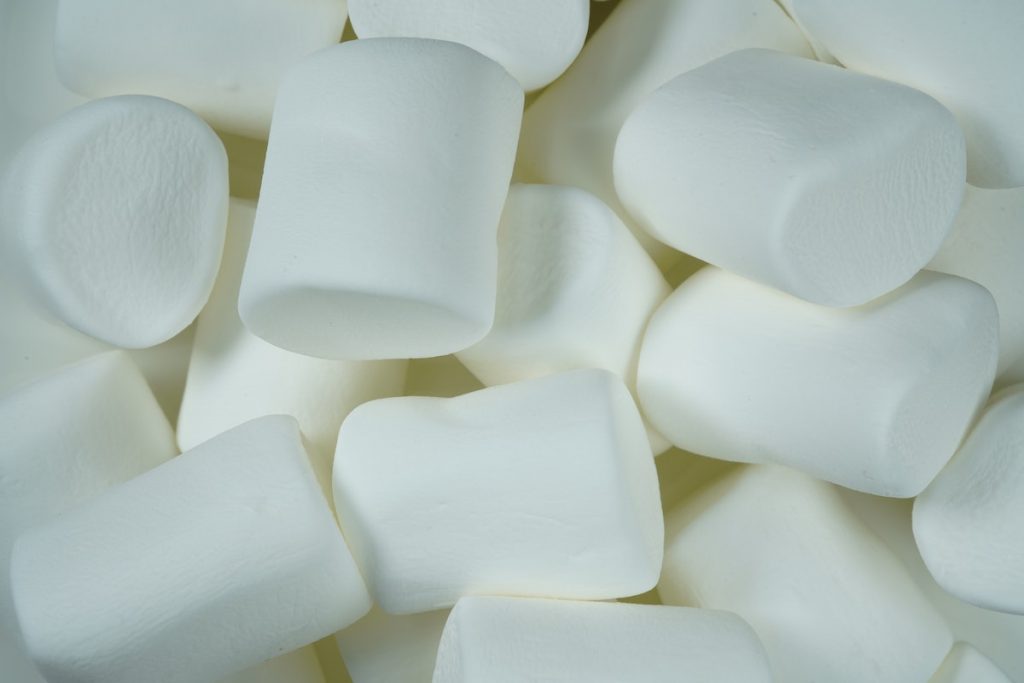Campfires and cookouts, as well as Rice Crispies and Lucky Charms, are not complete without those squishy and sweet marshmallows. Whether roasted or on their own, marshmallows are fun treats to eat by yourself or share with your friends. But some people can’t enjoy these fluffy treats for different reasons: they follow a gluten-free diet, have celiac disease, are vegan or are trying to shed some pounds.
If you are one of these three people, you might be wondering “Are marshmallows gluten-free? Can I still eat them or should I start looking for alternatives to stay healthy?”
Alternatives, however, aren’t always the best option, especially if you’re obsessed with jet puffed marshmallows or love to create recipes with marshmallows.
So are marshmallows gluten-free or do you need to bid cozy campfire s’mores adieu?
- Wait, What’s Gluten First?
- Are Marshmallows Gluten-Free?
- Are Marshmallows Vegan?
- Ingredients in Marshmallows That You Should Watch Out For
- Companies That Sell Gluten-Free Marshmallows
- Brands That Create Marshmallows Minus the Gluten
- But What About Marshmallow Fluff?
- How Can I Enjoy Gluten-Free Marshmallows?
Wait, What’s Gluten First?
The naturally occurring proteins found in barley, rye, wheat and triticale (a combination of rye and wheat) are called “gluten.” Gluten acts as “glue” that keeps these wheat products together to maintain their shape.
In processed foods, gluten takes the form of wheat derivatives or binders. If your marshmallows had gluten, it would be the additive, binder or flavoring.
People who have celiac disease or low tolerance to gluten need to avoid this protein at all costs. Gluten can trigger different symptoms, such as:
- Headaches
- Constipation
- Diarrhea
- Bloating
- Abdominal pain
Some food items — like cake, muffins and bread — are rich in gluten. You can also find gluten in unexpected foods, like marshmallows.
Are Marshmallows Gluten-Free?

For the most part, marshmallows are gluten-free. Many marshmallows produced in the US are made of gelatin, sugar and water. This makes them gluten-free and dairy-free food products. But there are some marshmallows made with ingredients like glucose syrup or wheat starch. Most marshmallow brands in the United States, however, are made from cornstarch.
It sounds confusing and to be honest, your trust issues can be tested when shopping for marshmallows. But the easiest and tried-and-tested way to find out if your marshmallows are gluten-free is to always check the label.
Gluten-free labeling is regulated by the Food and Drug Authority (FDA). This means some food companies are wary of putting gluten-free labels on their products even if their treats don’t contain gluten. So, if the marshmallow package you’re holding doesn’t have a gluten-free label, check the ingredient list to look for potential sources of gluten.
You’ll find that some brands may not have a gluten-free label on their package but don’t contain gluten in their ingredients. Other marshmallows may contain hidden sources of gluten.
This is where your judgment comes in. You can decide if the lack of gluten on the ingredients list is OK or if you’re uncomfortable with the potential cross-contamination. Your decision depends on your personal sensitivity to gluten or the role of gluten in your diet. Unless you have celiac disease, if a marshmallow product has a tiny hint of gluten, buying it is up to you.
Are Marshmallows Vegan?
Since most marshmallows contain gelatin, they aren’t for vegans. However, many brands are releasing vegan marshmallows. These include Trader Joe’s and Dandies.
Ingredients in Marshmallows That You Should Watch Out For
If you’re determined to buy gluten-free marshmallows, be thorough with your ingredient list inspection. Sometimes, gluten masquerades behind other names.
Here are ingredients that often contain gluten:
- Malt
- Bran
- Flour
- Spelt
- Rye
- Barley
- Wheat flour
- Wheat starch
- Wheat
- Natural coloring
- Natural flavors
- Secale cereal (rye)
- Modified food starch
- Artificial flavor
- Dextrin
- Maltodextrin
- Brown rice syrup
- Brewer’s yeast
Gluten cross-contamination is also possible during the food processing. Shared containers, cutting boards and flour sifters offer opportunities to sneak gluten into supposedly gluten-free marshmallows. According to the Celiac Disease Foundation, wheat flour can also stay airborne and accidentally contaminate foods nearby.
Although these cases are more likely to happen at a small bakery compared to a large plant, your safest bet is to buy gluten-free marshmallows from trusted brands.
Companies That Sell Gluten-Free Marshmallows

Many treats with marshmallows, like Lucky Charms Cereal and Swiss Miss Hot Chocolate, claim to be gluten-free. However, people with high sensitivity to gluten will still react to “gluten-free” marshmallows exposed to gluten in the same way they react to products with gluten.
So, if you want to be safe, it’s best to buy marshmallows from the following brands:
- Trader Joe’s. As mentioned above, Trader Joe’s mini marshmallows are vegan plus gluten-free. According to the company, they get their “melty marshmallows” from another business that is dedicated to making marshmallows without preservatives and artificial flavors, as well as using only vegan ingredients.
- Dandies. Dandies’ iconic marshmallows are gluten and gelatin-free. The best part is they are also free from common allergens. These marshmallows are available in different fun flavors like peppermint, mini vanilla, and pumpkin.
- Marshmallow Peeps. The original yellow Marshmallow Peeps are gluten-free since the company uses corn starch for their candies. They also list any potential cross-contamination sources or allergens to help buyers make an informed decision. Most Peeps marshmallows, however, do contain gelatin so they are not vegan-friendly.
- Campfire marshmallows. Perfect for s’mores, you’d be pleased to know that Campfire Marshmallows are dairy-free, gluten-free, nut-free and allergen-friendly. They’re the perfect marshmallows for people with food allergies or food intolerances. They are made with gelatin, though so they’re not vegan.
Brands That Create Marshmallows Minus the Gluten
As mentioned earlier, many companies add a gluten-free label on the marshmallows’ packaging. But there are some marshmallow brands that don’t have the gluten-free label yet their treats don’t have gluten.
The following brands are OK for people following a gluten-free diet despite not having the gluten-free label.
Kraft’s Jet-Puffed Marshmallows
Your favorite jet-puffed marshmallows may not have the gluten-free label on their packaging but their ingredients list is free from any gluten-containing ingredients. However, they may be subject to cross-contamination during the manufacturing process so use your judgment when it comes to buying your favorite jet-puffed marshmallows.
But What About Marshmallow Fluff?
Just like regular marshmallows, marshmallow fluff is gluten-free but similar to other food packages without the gluten-free label, check the ingredients list to make sure that you’re safe. But marshmallow fluff is not dairy-free or vegan since it contains egg whites.
How Can I Enjoy Gluten-Free Marshmallows?
If you’re following a strict diet or are sensitive to gluten, that doesn’t mean you can’t enjoy regular treats.
For example, a cup of hot chocolate is always the best during the cold weather. If you want to indulge in a healthier version of an old favorite, make your own Paleo hot chocolate. For the ingredients, you’ll need the following:
- Two and a half tablespoons of cocoa powder
- 5 ounce can of no-sugar-added coconut milk
- One and a half tablespoons of honey
Mix together the cocoa powder and coconut milk. Pour the mixture into a pot and keep the heat on low. Add a touch of honey for some sweetness and let it cook for a few minutes.
Another recipe you can try is:
Gluten-Free S’More Bars
Ingredients
- One teaspoon of baking soda
- Two and one-fourth cups of gluten-free all-purpose flour
- One teaspoon of salt
- Two sticks of softened dairy-free baking spread
- One-fourth cup of granulated sugar
- Three-fourth cups of packed light brown sugar. You can also switch to muscovado sugar.
- Two large eggs
- A bag of chocolate chips
- Ten-ounce bag of gluten-free mini marshmallows
Directions
- Preheat your oven to 350° F and line your metal baking pan with foil. Grease it with some non-stick cooking spray for good measure.
- Whisk together the salt, baking soda and flour. Combine the granulated sugar, brown sugar, vanilla extract and butter in another bowl. Cream them until smooth. Next, add one egg at a time until the mixture is blended well.
- Add the dry ingredients and mix until you form a dough. Add in the marshmallows and chocolate chips.
- Place and press the dough into the pan and bake until the edges are brown. The typical baking time is 30 minutes.
- Once the cookies are baked, remove them from the oven and let them cool. Watch the marshmallows melt as your s’mores cool.
- Place the pan on a baking sheet and top it with more marshmallows. Toast your marshmallows by broiling them. All it takes is two minutes.
- Allow the bars to cool again before you cut them into squares.
Marshmallows are essentials to some of your classic treats like hot chocolate, s’mores and ice cream. Fortunately, gluten need not stop you from enjoying them. Enjoy gluten-free marshmallows!


